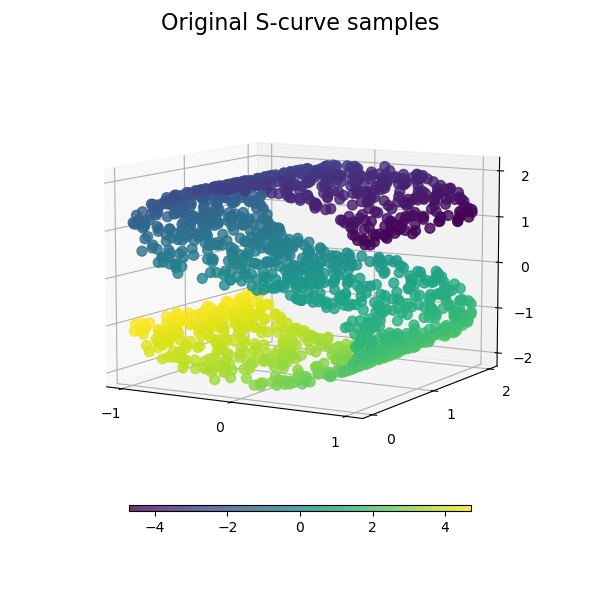W3cubDocs
/scikit-learnComparison of Manifold Learning methods
An illustration of dimensionality reduction on the S-curve dataset with various manifold learning methods.
For a discussion and comparison of these algorithms, see the manifold module page
For a similar example, where the methods are applied to a sphere dataset, see Manifold Learning methods on a severed sphere
Note that the purpose of the MDS is to find a low-dimensional representation of the data (here 2D) in which the distances respect well the distances in the original high-dimensional space, unlike other manifold-learning algorithms, it does not seeks an isotropic representation of the data in the low-dimensional space.

Out:
standard: 0.17 sec ltsa: 0.39 sec hessian: 0.51 sec modified: 0.41 sec Isomap: 0.47 sec MDS: 2.6 sec SpectralEmbedding: 0.22 sec t-SNE: 3.7 sec
# Author: Jake Vanderplas -- <[email protected]> print(__doc__) from time import time import matplotlib.pyplot as plt from mpl_toolkits.mplot3d import Axes3D from matplotlib.ticker import NullFormatter from sklearn import manifold, datasets # Next line to silence pyflakes. This import is needed. Axes3D n_points = 1000 X, color = datasets.samples_generator.make_s_curve(n_points, random_state=0) n_neighbors = 10 n_components = 2 fig = plt.figure(figsize=(15, 8)) plt.suptitle("Manifold Learning with %i points, %i neighbors" % (1000, n_neighbors), fontsize=14) try: # compatibility matplotlib < 1.0 ax = fig.add_subplot(251, projection='3d') ax.scatter(X[:, 0], X[:, 1], X[:, 2], c=color, cmap=plt.cm.Spectral) ax.view_init(4, -72) except: ax = fig.add_subplot(251, projection='3d') plt.scatter(X[:, 0], X[:, 2], c=color, cmap=plt.cm.Spectral) methods = ['standard', 'ltsa', 'hessian', 'modified'] labels = ['LLE', 'LTSA', 'Hessian LLE', 'Modified LLE'] for i, method in enumerate(methods): t0 = time() Y = manifold.LocallyLinearEmbedding(n_neighbors, n_components, eigen_solver='auto', method=method).fit_transform(X) t1 = time() print("%s: %.2g sec" % (methods[i], t1 - t0)) ax = fig.add_subplot(252 + i) plt.scatter(Y[:, 0], Y[:, 1], c=color, cmap=plt.cm.Spectral) plt.title("%s (%.2g sec)" % (labels[i], t1 - t0)) ax.xaxis.set_major_formatter(NullFormatter()) ax.yaxis.set_major_formatter(NullFormatter()) plt.axis('tight') t0 = time() Y = manifold.Isomap(n_neighbors, n_components).fit_transform(X) t1 = time() print("Isomap: %.2g sec" % (t1 - t0)) ax = fig.add_subplot(257) plt.scatter(Y[:, 0], Y[:, 1], c=color, cmap=plt.cm.Spectral) plt.title("Isomap (%.2g sec)" % (t1 - t0)) ax.xaxis.set_major_formatter(NullFormatter()) ax.yaxis.set_major_formatter(NullFormatter()) plt.axis('tight') t0 = time() mds = manifold.MDS(n_components, max_iter=100, n_init=1) Y = mds.fit_transform(X) t1 = time() print("MDS: %.2g sec" % (t1 - t0)) ax = fig.add_subplot(258) plt.scatter(Y[:, 0], Y[:, 1], c=color, cmap=plt.cm.Spectral) plt.title("MDS (%.2g sec)" % (t1 - t0)) ax.xaxis.set_major_formatter(NullFormatter()) ax.yaxis.set_major_formatter(NullFormatter()) plt.axis('tight') t0 = time() se = manifold.SpectralEmbedding(n_components=n_components, n_neighbors=n_neighbors) Y = se.fit_transform(X) t1 = time() print("SpectralEmbedding: %.2g sec" % (t1 - t0)) ax = fig.add_subplot(259) plt.scatter(Y[:, 0], Y[:, 1], c=color, cmap=plt.cm.Spectral) plt.title("SpectralEmbedding (%.2g sec)" % (t1 - t0)) ax.xaxis.set_major_formatter(NullFormatter()) ax.yaxis.set_major_formatter(NullFormatter()) plt.axis('tight') t0 = time() tsne = manifold.TSNE(n_components=n_components, init='pca', random_state=0) Y = tsne.fit_transform(X) t1 = time() print("t-SNE: %.2g sec" % (t1 - t0)) ax = fig.add_subplot(2, 5, 10) plt.scatter(Y[:, 0], Y[:, 1], c=color, cmap=plt.cm.Spectral) plt.title("t-SNE (%.2g sec)" % (t1 - t0)) ax.xaxis.set_major_formatter(NullFormatter()) ax.yaxis.set_major_formatter(NullFormatter()) plt.axis('tight') plt.show()
Total running time of the script: (0 minutes 9.163 seconds)
plot_compare_methods.py
plot_compare_methods.ipynb
© 2007–2016 The scikit-learn developers
Licensed under the 3-clause BSD License.
http://scikit-learn.org/stable/auto_examples/manifold/plot_compare_methods.html